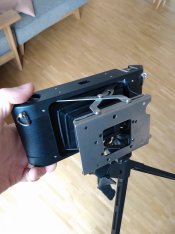I have recently started a project to turn a broken Lomography 6x12 folding camera into a lightweight travel companion with an upgraded lens. I picked a Schneider Kreuznach Angulon 90mm f/6.8 in a Synchro-Compur #0 shutter as my replacement lens, but also have a Angulon 120mm f/6.8 available. Now, on to my problem. I stripped down the camera and I am planning on adding a custom "lens board", potentially with a helicoid, to the front face.

I am struggling a little with determining the correct focus distances (film plane to lens) for the focus range of the lens. According to this link (http://www.hyam.net/blog/archives/3961) the 90mm has a flange focal distance of 90mm at infinity. As far as I am aware that is measured as the distance from the film plane to the optical centre of the lens. How can I relate this back to for example the rear element to design my spacer parts more accurately?
Additionally, how do I determine the distance between lens and film plane at any given focus distance? I want to add a helicoid in order to enable focus from let’s say 2m to infinity. I am a little worried about the bellows size of the Lomography camera though, and hence need to figure out if the small end of the bellows is large enough to accommodate the lens when it is focussed at near distances (without vignetting). The bellows extend from a slightly smaller than 6x12 film plane (52 x 103mm) to an opening of 34mm x 36mm at the small end of the bellows over a length (film plane to bellow end) of 77mm.
Should close focus not be possible with the current bellows and folding mechanism, I might make this one fixed to infinity and later build a new one from scratch.

I am struggling a little with determining the correct focus distances (film plane to lens) for the focus range of the lens. According to this link (http://www.hyam.net/blog/archives/3961) the 90mm has a flange focal distance of 90mm at infinity. As far as I am aware that is measured as the distance from the film plane to the optical centre of the lens. How can I relate this back to for example the rear element to design my spacer parts more accurately?
Additionally, how do I determine the distance between lens and film plane at any given focus distance? I want to add a helicoid in order to enable focus from let’s say 2m to infinity. I am a little worried about the bellows size of the Lomography camera though, and hence need to figure out if the small end of the bellows is large enough to accommodate the lens when it is focussed at near distances (without vignetting). The bellows extend from a slightly smaller than 6x12 film plane (52 x 103mm) to an opening of 34mm x 36mm at the small end of the bellows over a length (film plane to bellow end) of 77mm.
Should close focus not be possible with the current bellows and folding mechanism, I might make this one fixed to infinity and later build a new one from scratch.


